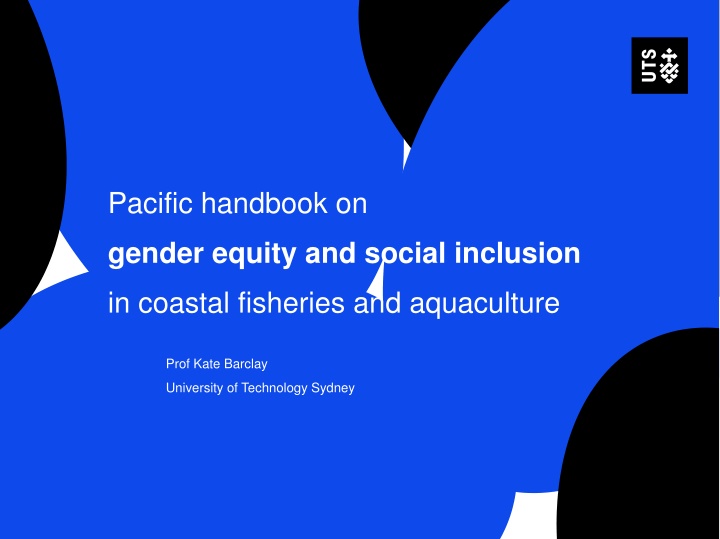
Handbook on Gender Equity and Social Inclusion in Coastal Fisheries
Explore the Pacific handbook focusing on gender equity and social inclusion in coastal fisheries and aquaculture, authored by Prof. Kate Barclay from the University of Technology Sydney. The handbook aims to improve community benefits from fisheries and aquaculture, emphasizing gender equality and social inclusion in resource management and extension activities. Discover the origins, purpose, and contents of the handbook, addressing sustainable well-managed fisheries, the importance of GSI analysis, and more.
Download Presentation

Please find below an Image/Link to download the presentation.
The content on the website is provided AS IS for your information and personal use only. It may not be sold, licensed, or shared on other websites without obtaining consent from the author. If you encounter any issues during the download, it is possible that the publisher has removed the file from their server.
You are allowed to download the files provided on this website for personal or commercial use, subject to the condition that they are used lawfully. All files are the property of their respective owners.
The content on the website is provided AS IS for your information and personal use only. It may not be sold, licensed, or shared on other websites without obtaining consent from the author.
E N D
Presentation Transcript
Pacific handbook on gender equity and social inclusion in coastal fisheries and aquaculture Prof Kate Barclay University of Technology Sydney
2 Purpose of the handbook
3 Sustainable well-managed inshore fisheries, underpinned by community-based approaches that provide food security, and long-term economic, social and ecological benefits to our communities. A New Song for Coastal Fisheries: Noumea Strategy
4 PURPOSE OF THE HANDBOOK Improve whole-of-community benefits from fisheries/aquaculture Sometimes resource management and extension activities benefit only some members of communities, while others are left behind. Audience: government staff working in coastal fisheries and aquaculture Oriented around the tasks staff undertake How can gender equity and social inclusion be improved in these tasks? For project/programme recipients? Internally within fisheries agencies? PHOTO CREDIT: KATE BARCLAY
5 Origin of the handbook
6 ORIGINS OF THE HANDBOOK Gender and government agencies for fisheries/aquaculture ACIAR projects community-based fisheries and aquaculture How connect to government? Interviews April-May 2017 Solomon Islands, Vanuatu, Kiribati Staff want/need to include gender, but how? Model: Pacific Gender Climate Change Toolkit Collaborative workshops Fiji November 2017, 2018 PHOTO CREDIT: KATE BARCLAY
7 Handbook contents
8 HANDBOOK CONTENTS Introduction Module 1 Social dimensions of coastal fisheries and aquaculture Why promoting gender equity and social inclusion improves fisheries and aquaculture outcomes Equity and equality? Mainstreaming gender and social inclusion International commitments to shared benefits, social inclusion and gender equality PHOTO CREDIT: KATE BARCLAY
9 HANDBOOK CONTENTS GSI analysis Module 2 When and why should we do a GSI analysis? Recognising discrimination How to do a GSI analysis Data and methods Topic areas for GSI analyses Two tools for GSI analysis PHOTO CREDIT: KATE BARCLAY
10 HANDBOOK CONTENTS Monitoring evaluation & learning (MEL) Module 3 What is MEL? Are we doing things right? Are we doing the right things? Have we adapted how we do things? Key steps for MEL in project management Tips for integrating GSI in MEL Types of GSI indicators, data Adaptive management Tools and resources PHOTO CREDIT: SIMON FOALE
11 HANDBOOK CONTENTS Government processes & the policy cycle Modules 4 & 5 Mainstreaming GSI in government processes GSI capacity of Pacific governments. Mainstreaming gender in fisheries agencies Strategic documents Steering committees International negotiations How governance systems affect GSI Key stages of the policy cycle Preparation, Drafting, Stakeholder consultation, Redrafting, Validation consultation, Formal approval, Implementation, MEL, Review PHOTO CREDIT: KATE BARCLAY
12 HANDBOOK CONTENTS Community engagement Livelihoods projects Coastal fisheries management Modules to be developed PHOTO CREDIT: KATE BARCLAY
Editors: Barclay, K. Leduc, B. Mangubhai, S. Donato-Hunt, C. Authors: Barclay, K., Leduc, B., Mangubhai, S. , Vunisea, A., Namakin, B., Teimarane, M., Leweniqila, L., Kunatuba, J., Danford, M., Rakuro, M., Kleiber, D., Sanders, J., Kunatuba, J., Raubani, J., Streeter, M. Thank you Merci beaucoup Other contributors: Andrew, N., Baereleo, R., Botaake Teetu,S., Cohen, P., Hunt, A., Kinch, J., Kumar, P., Lawless, S., Masu, R., Mauli, S., Morris, M., Neihapi, P., Opa, T., Restrepo, A., Stacey, N., Tawake, L., Tiitii, U.
Funding: the Australian Government and the Australian Centre for International Agricultural Research (ACIAR) (FIS/2012/076 and FIS/2016/300) and the United Nations Food and Agriculture Organization (FAO) Subregional Office (Apia). Other contributing organisations: Pacific Community (SPC), Pacific Islands Forum Fisheries Agency (FFA), WorldFish.
